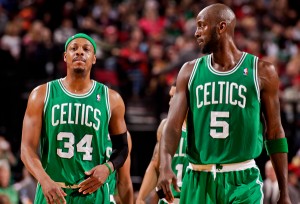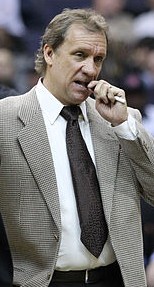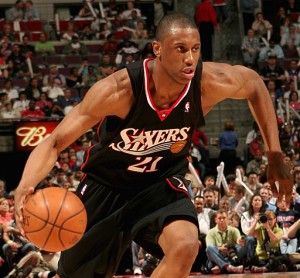
 Seven years ago, the Minnesota Timberwolves traded their prized power forward (Kevin Garnett) across conferences to the Boston Celtics. This Eastern Conference squad had made headlines a few weeks earlier, acquiring a superstar wing (Ray Allen) to accompany the team’s lone All-Star (Paul Pierce).
Seven years ago, the Minnesota Timberwolves traded their prized power forward (Kevin Garnett) across conferences to the Boston Celtics. This Eastern Conference squad had made headlines a few weeks earlier, acquiring a superstar wing (Ray Allen) to accompany the team’s lone All-Star (Paul Pierce).
This summer, the Timberwolves traded their prized power forward (Kevin Love) across conferences to the Cleveland Cavaliers. This Eastern Conference squad had made headlines a few weeks earlier, acquiring a superstar wing (LeBron James) to accompany the team’s lone All-Star (Kyrie Irving).
Here’s the difference. The first time around, the Timberwolves went with a total rebuild, stocking up draft picks and expiring contracts. Everyone knew the Timberwolves would be bad, including the Timberwolves.
This time, GM Flip Saunders and the Wolves are trying to stay competitive. Yes, they traded their superstar for a rookie, but Andrew Wiggins projects as a perennial All-Star. They also brought in veteran Thaddeus Young, who would normally not be part of any demolition plan.
On top of that, the presence – physically and contractually – of Nikola Pekovic, Kevin Martin and Corey Brewer lead most to believe that the Wolves will at the very least try to make a push for the playoffs this season.
It may not go the way the Wolves want, but the attempt does bring forth some interesting storylines. Here are five things to watch.
1. Flip Saunders in two roles. One of the first transactions of the summer came when president of basketball operations Flip Saunders had to make the tough choice of finding a replacement for 1,000-win coach Rick Adelman.  Ultimately, he decided to keep it in house – very in house. After a failed attempt to bring in Memphis coach (and Minnesota native) Dave Joerger and a series of interviews with others, Saunders determined that returning to the sidelines would be the best course of action in the short term.
Ultimately, he decided to keep it in house – very in house. After a failed attempt to bring in Memphis coach (and Minnesota native) Dave Joerger and a series of interviews with others, Saunders determined that returning to the sidelines would be the best course of action in the short term.
Obviously, this will have its upsides and its downsides. The upside is that Saunders is able to acquire players for his system. He won’t have a coach to battle over strategy and rotation supremacy. The downside is the ridiculous amount of power Saunders holds as the only part-owner/president/coach in the entire league. Flip has had his successes over the years, but that’s a lengthy job title for a guy with zero championships. Still, no Wolves coach has ever had the success Flip has had on the bench, so he will get the benefit of the doubt for now.
2. The development of Ricky Rubio. As I mentioned in my season review of the 2013-14 Timberwolves – and as everyone saw – Rubio had a rough season putting the ball in the basket. While he hovered around the league average from behind the arc, he could not finish around the rim or at mid-range. Still, it should also be noted that his finishing around the rim improved by 10 percent after the All-Star break.
Ironically, part of the problem was Love’s presence. While he was clearly the Wolves’ best player – and the guy who gave Rubio the largest chunk of his assists – he also played with the ball in his hands a lot. This forced Rubio to play off the ball, and he is not a catch-and-shoot player. With Love gone, Rubio will have a chance to return to the pick-and-roll with Pekovic. The ability of Martin and Young to play well off the ball should make for even more freedom for Rubio. He has a lot to prove, and this year will be his best chance yet.
3. Interior defense. When Love was traded, Wolves fans could at least envision a replacement with some rim protector qualities. While Young is annually among the top five in steals per game, rim protection at power forward is not one of his skills. As reported by Bill Simmons on Grantland, among those averaging 30-plus minutes at power forward or center last season, Young was the worst interior defender, allowing 60.2 percent shooting. Love (57.4 percent) was third and Pekovic (55.2 percent) fifth.
qualities. While Young is annually among the top five in steals per game, rim protection at power forward is not one of his skills. As reported by Bill Simmons on Grantland, among those averaging 30-plus minutes at power forward or center last season, Young was the worst interior defender, allowing 60.2 percent shooting. Love (57.4 percent) was third and Pekovic (55.2 percent) fifth.
The glimmer of hope for the Wolves lies in second-year big man Gorgui Dieng. He came on in the last 18 games of the season and played well enough to win Rookie of the Month for April and earn All-Rookie Second Team honors. With Pekovic’s injury history, odds are that a cap of around 28 minutes will be placed on him. This will give Dieng a chance to prove last season – and his strong performance in the FIBA World Cup this summer – was no fluke.
4. A bolstered bench. Last season, Minnesota’s bench was arguably the worst in the league and certainly the worst among Western Conference playoff contenders. It was 29th in both overall and 3-point percentage and 28th in defensive efficiency, according to hoopstats.com. Part of this was the sluggish play of injury-riddled Chase Budinger, who could never really get his shot back where it was pre-injury, connecting at an extremely inconsistent 35 percent. The other part was J.J. Barea, who was asked to play the roles of primary bench scoring option and distributor. He is a skilled player, but that was asking too much.
The trade of Love changes things a bit. Assuming Dieng is not a fluke, and combined with Anthony Bennett, Zach LaVine,
newly signed veteran Mo Williams and Corey Brewer (unless he starts over Andrew Wiggins), the firepower off the bench should be improved. Not that that’s saying much.
RELATED: Timberwolves salaries and analysis
5. Dunks, alley oops and more dunks! Everyone knows Rubio can delivery pinpoint passes with a lot of flash. Everyone knows Wiggins, LaVine, Brewer and Glenn Robinson III all have memorable dunks in their pasts. (Remember Brewer’s dunk on Derek Fisher?)
This season may not bring a lot of wins, but if the Dunking with Wolves show the team held on September 29 is any kind of a realistic preview, the path is going to be exciting.
READ EVERY TEAM’S SEASON PREVIEW WITH OUR INDEX
Tim Faklis is a writer for ESPN Truehoop Network’s A Wolf Among Wolves, a blog dedicated to covering the Minnesota Timberwolves. He has also written and/or had work featured at Sheridan Hoops, SB Nation’s Canis Hoopus and Hardwood Paroxysm. You can follow him on Twitter @timfaklis.